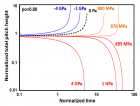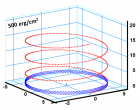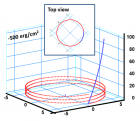Abstract
Research Article
Mesoscopic irreversible thermodynamics of morphological evolution kinetics of helical conformation in bioproteins ‘DNA’ under the isothermal isobaric conditions
Tarik Omer Ogurtani* and Ersin Emre Oren
Published: 11 March, 2020 | Volume 4 - Issue 1 | Pages: 009-019
The morphological evolution kinetics and instabilities of alpha helical peptide 3.613, which involves large amount of stored torsional elastic deformation energy (3-40 eV/molecule), is formulated by the variational method based on the connection between the rates of internal entropy production and the changes in the global Gibbs free energy, assuming that one has isobaric irreversible processes under the isothermal conditions. The present mesoscopic nonequilibrium thermodynamic approach relies on the fact that the global Gibbs free energy of helical conformation involves not only the bulk Gibbs free energy of the amino-acid back bone structure but also the interfacial Gibbs free energy of the enclosing cylindrical shell or the cage associated with the side-wall molecular branches, and their interactions with the immediate surroundings. The proposed variational analysis applied directly on the proposed macro-model has furnished a nonlinear integral equation in terms of the normalized and scaled internal and external variables. This allows us to track down the motion of the total pitch height of the alpha polypeptide along the well-defined trajectories in the displacement-time space, dictated not only by the initial configuration of the helix but also through the gradients of the global Gibbs free energy of the strained helical conformation as the main driving force. In the negative manifold, there is a well-defined region below the dynamic instability regime, in which the helical conformation can evolve towards the nonequilibrium stationary states by expanding, or contracting, depending upon whether the interfacial free energy and/or the applied stress system are below or above the well-defined thresholds level dictated by the initial pitch height. The highest life time may be realized along that trajectory, which follows up the threshold level of the interfacial specific Gibbs free energy, which is gs = -315 erg/cm2. In the upper region of the negative manifold, the helical conformations are driven by the very large applied uniaxial tension or the negative pressure induced by the thermal expansion, in the range of p > 1GPa and/or the strong negative interfacial free energies [3-4 pH] or their combinations, they show strong kinematic instabilities, which can cause not only the accelerated unfolding phenomenon but also cause large extensions that end up with the catastrophic decimations by ruptures and fragmentations. In the positive manifold, the aging behavior of the polypeptide follows up a S-shape path having rather speedy aging behavior compared to the negative manifold, which is separated from by a well-defined boundary, which represents the isochoric path having longest relaxation times, which can be achieved with great stability. Finally, one could attempt to estimate the upper limit of the relaxation time of aging for the modern hominin, from samples of exceptional preservations, relying on the present nonequilibrium theory as well as on the very limited knowledge on the post-mortem DNA and the present pitch heights of the modern hominin, which is found to be about 25,840 yrs, with a life expectation of 451,800 yrs. These figures are very close to those calculated for Neanderthals (SH), which are found to be 31,820 yrs and 499,100 yrs, respectively.
Read Full Article HTML DOI: 10.29328/journal.abse.1001008 Cite this Article Read Full Article PDF
Keywords:
Aptasensor; Cardiac troponin I; Antifouling; Surface plasmon resonance; Myocardial Infarction
References
- Idiris A, Taufiq M, Ikai A. Spring mechanics of α–helical polypeptide. Protein Eng. 2000; 13: 763-770. PubMed: https://www.ncbi.nlm.nih.gov/pubmed/11161107
- Misères A, Guenette PA. Phase transition-induced elasticity of alpha-helical bioelastometric fibers and networks. Chem Soc Rev. 2013; 42: 1973-1995. PubMed: https://www.ncbi.nlm.nih.gov/pubmed/23229440
- Ackbarow T, Chen X, Sinan K, Buehler MJ. Hierarchies, multiple energy barriers, and robustness govern the fracture mechanics of α-helical and β-sheet protein domains. Proc Natl Acad Sci U S A. 2007; 104: 16419-16415. PubMed: https://www.ncbi.nlm.nih.gov/pubmed/17925444
- Carrion-Vazquez M, Oberhauser AF, Fisher TE, Marszalek PE, Li H, et al. Mechanical design of proteins studied by single-molecule force spectroscopy and protein engineering. Prog Biophys Mol Biol. 2000; 74: 63-91. PubMed: https://www.ncbi.nlm.nih.gov/pubmed/11106807
- Rief M, Pascual J, Saraste M, Gaub HE. Single molecular force spectroscopy of spectrin repeats: Low unfolding forces in helix bundles. J Mol Biol. 1999; 286: 553-561. PubMed: https://www.ncbi.nlm.nih.gov/pubmed/9973570
- Bell GI. Model for the specific adhesion of cells to cells. Science. 1978; 200: 684-293. PubMed: https://www.ncbi.nlm.nih.gov/pubmed/347575
- Yeremin EN. The Foundations of Chemical Kinetics. MIR Publishers-Moscow. 1976; 214-241.
- Christian JW. The theory of transformations in metals and alloys, CH-3. Pergamum Press Oxford. 1975; 77-104.
- Ogurtani TO. Enlarged version includes variational optimization of the length and Helmholtz binding free energy of a-helix: Curvature, Torsion and Torque in Helical Conformations and the Stability and Growth of alpha-Peptides under the Isochoric and Isobaric Conditions.
- Kitano H. Computational system biology. Nature. 2002; 420: 206-210.
- Pauling L, Corey RB, Branson HR. The structure of proteins: Two hydrogen bonded helical configuration of polypeptide chain, Proc Natl Acad Sci U S A. 1951; 37: 205-211. PubMed: https://www.ncbi.nlm.nih.gov/pubmed/14816373
- Smeller L. Pressure-temperature phase diagrams of biomolecules. Biochim Biophys Acta. 2002; 1595: 11-29. PubMed: https://www.ncbi.nlm.nih.gov/pubmed/11983384
- Kojima H, Ishijima A, Yanagida T. Direct measurement of stiffness of single actin filaments with and without tropomyosin by in vitro nanomanipulation. Proc Natl Acad Sci U S A. 1994; 91: 12962-12966. PubMed: https://www.ncbi.nlm.nih.gov/pubmed/7809155
- Radmacher M, Fritz M, Cleveland JP, Walters DR, Hansman PK. Imaging adhesion forces and elasticity of Iysozyme adsorbed on mica by atomic force microscopy. Langmuir. 1994; 10: 3809-3814.
- Afin R, Alam MT, Ikai A. Pretransition and progressive softening of bovine carbonic anhydrase II as probed by single molecule atomic force microscopy. Protein Sci. 2005; 14: 1447-1457. PubMed: https://www.ncbi.nlm.nih.gov/pubmed/15929995
- Afin R, Takahashi I, Shiga K, Ikai A. Tensile mechanics of alanine-based helical polypeptide: Force spectroscopy versus computer simulations. Biophy J. 2009; 96: 1105-1114. PubMed: https://www.ncbi.nlm.nih.gov/pubmed/19186146
- Qin Z, Kreplak L, Buehler MJ. Nanomechanical properties of vimentin intermediate filament dimers. Nanotechnology. 2009; 20: 425101-425108. PubMed: https://www.ncbi.nlm.nih.gov/pubmed/19779230
- Middelberg APJ, He L, Dexter AF, Shen HH, Holt SA, et al. The interfacial structure and Young’s modulus of peptide films having switchable mechanical properties. J R Soc Interface. 2008; 5: 47-54. PubMed: https://www.ncbi.nlm.nih.gov/pubmed/17550885
- Lei PF, Raae AJ, Altmann SM, Saraste M, Hörber JKH. States and transitions during forced unfolding of a single spectrin repeat. FEBS Lett. 2000; 476: 124-128. PubMed: https://www.ncbi.nlm.nih.gov/pubmed/10913598
- Ogurtani TO. Mesoscopic nonequilibrium thermodynamics of solid surfaces and interfaces with triple junction singularities under the capillary and electromigration forces in anisotropic three-dimensional space. J Chem Phys. 2006; 124: 144706. PubMed: https://www.ncbi.nlm.nih.gov/pubmed/16626230
- Ogurtani TO. Variational formulation of irreversible thermodynamics of surfaces and interfaces with grain-boundary triple junction singularities under the capillary and electromigration forces in anisotropic two-dimensional space. Phys Rev B. 2006; 73: 235408.
- Ogurtani TO. Variational formulation of irreversible thermodynamics of isochoric and isobaric systems. 2015.
- Hildebrand FB. Methods of applied mathematics. Prentice Hall, Englewood. 1961; 122.
- Truesdell C. Thermodynamics of deformation, in nonequilibrium thermodynamics variational techniques and stability. Edited: R.J. Donnelly, R. Herman, I. Prigogine, Proceedings of Symposium, University of Chicago. 1965; 101-114.
- Prigogine I, Int Thermodynamics of irreversible processes. Interscience Publ. 1955; 75.
- De Groot SR. Thermodynamics of irreversible processes. North-Holland Co. Amsterdam. 1961; 22.
- Ogurtani TO. Unified theory of linear instability of anisotropic surfaces and interfaces under capillary, electrostatic, and elastostatic forces: The regrowth of epitaxial amorphous silicon. Phys Rev B. 2006; 74: 1-23.
- Ogurtani TO, Oren EE. Irreversible thermodynamics of triple junctions during the intergranular void motion under the electromigration forces. Int J Solids Structures. 2005; 42: 3918-3952.
- Demaret JP, Gueron M. Composite cylinder models of DNA: Application to the electrostatic of B-Z transition. Biophys J. 1993; 65: 1700-1713. PubMed: https://www.ncbi.nlm.nih.gov/pubmed/8274658
- Weatherburn CE. Elementary Vector Analysis, with Application to Geometry and Mechanics. G Bell and Sons. 1955; 99-102.
- Timoshenko S, Goodier JN. Theory of elasticity. McGraw-Hill New York. 1951; 361.
- Cheatham TE, Case DA. Twenty-Five years of nucleic acid simulations. Biopolymers. 2013; 99: 969-977. PubMed: https://www.ncbi.nlm.nih.gov/pubmed/23784813
- Huang Y, Li L. DNA crosslinking damage and cancer-a table of friend and the foe. Transl Cancer Res. 2013; 2: 144-154. PubMed: https://www.ncbi.nlm.nih.gov/pubmed/23998004
- Allentoft ME, Collins M, Harker D, Haile J, Oskam CL, et al. The half-life of DNA in bone: measuring decay kinetics in 158 dated fossils. Proc Biol Sci. 2012; 279: 4724-4733. PubMed: https://www.ncbi.nlm.nih.gov/pubmed/23055061
- scientificamerican.com/.../oldest-ancient-human-dna-details-dawn. 2016.
- Callaway E. 45,000 years old man’s genome sequenced. Nature magazine. 2016.
Figures:

Figure 1

Figure 2

Figure 3

Figure 4

Figure 5

Figure 6

Figure 7

Figure 8

Figure 9

Figure 10
Similar Articles
-
Peptide-based antifouling aptasensor for cardiac troponin I detection by surface plasmon resonance applied in medium sized Myocardial InfarctionJen-Tsai Liu*,Yi Wu,Jia Xin Che,Shwu Jen Chang,Ching-Jung Chen*. Peptide-based antifouling aptasensor for cardiac troponin I detection by surface plasmon resonance applied in medium sized Myocardial Infarction. . 2020 doi: 10.29328/journal.abse.1001007; 4: 001-008
Recently Viewed
-
Adult Neurogenesis: A Review of Current Perspectives and Implications for Neuroscience ResearchAlex, Gideon S*,Olanrewaju Oluwaseun Oke,Joy Wilberforce Ekokojde,Tolulope Judah Gbayisomore,Martina C. Anene-Ogbe,Farounbi Glory,Joshua Ayodele Yusuf. Adult Neurogenesis: A Review of Current Perspectives and Implications for Neuroscience Research. J Neurosci Neurol Disord. 2024: doi: 10.29328/journal.jnnd.1001102; 8: 106-114
-
Late discover of a traumatic cardiac injury: Case reportBenlafqih C,Bouhdadi H*,Bakkali A,Rhissassi J,Sayah R,Laaroussi M. Late discover of a traumatic cardiac injury: Case report. J Cardiol Cardiovasc Med. 2019: doi: 10.29328/journal.jccm.1001048; 4: 100-102
-
A two-phase sonographic study among women with infertility who first had normal sonographic findingsKalu Ochie*,Abraham John C. A two-phase sonographic study among women with infertility who first had normal sonographic findings. Clin J Obstet Gynecol. 2022: doi: 10.29328/journal.cjog.1001117; 5: 101-103
-
Sinonasal Myxoma Extending into the Orbit in a 4-Year Old: A Case PresentationJulian A Purrinos*, Ramzi Younis. Sinonasal Myxoma Extending into the Orbit in a 4-Year Old: A Case Presentation. Arch Case Rep. 2024: doi: 10.29328/journal.acr.1001099; 8: 075-077
-
Analysis of Psychological and Physiological Responses to Snoezelen Multisensory StimulationLucia Ludvigh Cintulova,Jerzy Rottermund,Zuzana Budayova. Analysis of Psychological and Physiological Responses to Snoezelen Multisensory Stimulation. J Neurosci Neurol Disord. 2024: doi: 10.29328/journal.jnnd.1001103; 8: 115-125
Most Viewed
-
Evaluation of Biostimulants Based on Recovered Protein Hydrolysates from Animal By-products as Plant Growth EnhancersH Pérez-Aguilar*, M Lacruz-Asaro, F Arán-Ais. Evaluation of Biostimulants Based on Recovered Protein Hydrolysates from Animal By-products as Plant Growth Enhancers. J Plant Sci Phytopathol. 2023 doi: 10.29328/journal.jpsp.1001104; 7: 042-047
-
Sinonasal Myxoma Extending into the Orbit in a 4-Year Old: A Case PresentationJulian A Purrinos*, Ramzi Younis. Sinonasal Myxoma Extending into the Orbit in a 4-Year Old: A Case Presentation. Arch Case Rep. 2024 doi: 10.29328/journal.acr.1001099; 8: 075-077
-
Feasibility study of magnetic sensing for detecting single-neuron action potentialsDenis Tonini,Kai Wu,Renata Saha,Jian-Ping Wang*. Feasibility study of magnetic sensing for detecting single-neuron action potentials. Ann Biomed Sci Eng. 2022 doi: 10.29328/journal.abse.1001018; 6: 019-029
-
Pediatric Dysgerminoma: Unveiling a Rare Ovarian TumorFaten Limaiem*, Khalil Saffar, Ahmed Halouani. Pediatric Dysgerminoma: Unveiling a Rare Ovarian Tumor. Arch Case Rep. 2024 doi: 10.29328/journal.acr.1001087; 8: 010-013
-
Physical activity can change the physiological and psychological circumstances during COVID-19 pandemic: A narrative reviewKhashayar Maroufi*. Physical activity can change the physiological and psychological circumstances during COVID-19 pandemic: A narrative review. J Sports Med Ther. 2021 doi: 10.29328/journal.jsmt.1001051; 6: 001-007

HSPI: We're glad you're here. Please click "create a new Query" if you are a new visitor to our website and need further information from us.
If you are already a member of our network and need to keep track of any developments regarding a question you have already submitted, click "take me to my Query."














































































































































